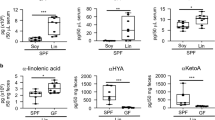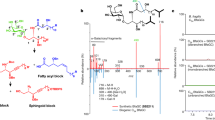Abstract
Parasitic worms express host-like glycans to attenuate the immune response of human hosts. The therapeutic potential of this immunomodulatory mechanism in controlling the metabolic dysfunction that is associated with chronic inflammation remains unexplored. We demonstrate here that administration of lacto-N-fucopentaose III (LNFPIII), a LewisX-containing immunomodulatory glycan found in human milk and on parasitic helminths, improves glucose tolerance and insulin sensitivity in diet-induced obese mice. This effect is mediated partly through increased interleukin-10 (Il-10) production by LNFPIII-activated macrophages and dendritic cells, which reduces white adipose tissue inflammation and sensitizes the insulin response of adipocytes. Concurrently, LNFPIII treatment upregulates nuclear receptor subfamily 1, group H, member 4 (Fxr-α, also known as Nr1h4) to suppress lipogenesis in the liver, conferring protection against hepatosteatosis. At the signaling level, the extracellular signal-regulated kinase (Erk)-activator protein 1 (Ap1) pathway seems to mediate the effects of LNFPIII on both inflammatory and metabolic pathways. Our results suggest that LNFPIII may provide new therapeutic approaches to treat metabolic diseases.
This is a preview of subscription content, access via your institution
Access options
Subscribe to this journal
Receive 12 print issues and online access
$209.00 per year
only $17.42 per issue
Buy this article
- Purchase on Springer Link
- Instant access to full article PDF
Prices may be subject to local taxes which are calculated during checkout






Similar content being viewed by others
References
Gregor, M.F. & Hotamisligil, G.S. Inflammatory mechanisms in obesity. Annu. Rev. Immunol. 29, 415–445 (2011).
Arkan, M.C. et al. IKK-β links inflammation to obesity-induced insulin resistance. Nat. Med. 11, 191–198 (2005).
Cai, D. et al. Local and systemic insulin resistance resulting from hepatic activation of IKK-β and NF-κB. Nat. Med. 11, 183–190 (2005).
Chiang, S.H. et al. The protein kinase IKKɛ regulates energy balance in obese mice. Cell 138, 961–975 (2009).
Nakamura, T. et al. Double-stranded RNA-dependent protein kinase links pathogen sensing with stress and metabolic homeostasis. Cell 140, 338–348 (2010).
Shi, H. et al. TLR4 links innate immunity and fatty acid–induced insulin resistance. J. Clin. Invest. 116, 3015–3025 (2006).
Vandanmagsar, B. et al. The NLRP3 inflammasome instigates obesity-induced inflammation and insulin resistance. Nat. Med. 17, 179–188 (2011).
Wen, H. et al. Fatty acid–induced NLRP3-ASC inflammasome activation interferes with insulin signaling. Nat. Immunol. 12, 408–415 (2011).
Feuerer, M. et al. Lean, but not obese, fat is enriched for a unique population of regulatory T cells that affect metabolic parameters. Nat. Med. 15, 930–939 (2009).
Kang, K. et al. Adipocyte-derived Th2 cytokines and myeloid PPARδ regulate macrophage polarization and insulin sensitivity. Cell Metab. 7, 485–495 (2008).
Nishimura, S. et al. CD8+ effector T cells contribute to macrophage recruitment and adipose tissue inflammation in obesity. Nat. Med. 15, 914–920 (2009).
Odegaard, J.I. et al. Alternative M2 activation of Kupffer cells by PPARδa ameliorates obesity-induced insulin resistance. Cell Metab. 7, 496–507 (2008).
Winer, S. et al. Normalization of obesity-associated insulin resistance through immunotherapy. Nat. Med. 15, 921–929 (2009).
Weisberg, S.P. et al. Obesity is associated with macrophage accumulation in adipose tissue. J. Clin. Invest. 112, 1796–1808 (2003).
Xu, H. et al. Chronic inflammation in fat plays a crucial role in the development of obesity-related insulin resistance. J. Clin. Invest. 112, 1821–1830 (2003).
Lumeng, C.N., Bodzin, J.L. & Saltiel, A.R. Obesity induces a phenotypic switch in adipose tissue macrophage polarization. J. Clin. Invest. 117, 175–184 (2007).
Gordon, S. Alternative activation of macrophages. Nat. Rev. Immunol. 3, 23–35 (2003).
Wu, D. et al. Eosinophils sustain adipose alternatively activated macrophages associated with glucose homeostasis. Science 332, 243–247 (2011).
Odegaard, J.I. et al. Macrophage-specific PPARγ controls alternative activation and improves insulin resistance. Nature 447, 1116–1120 (2007).
Hong, E.G. et al. Interleukin-10 prevents diet-induced insulin resistance by attenuating macrophage and cytokine response in skeletal muscle. Diabetes 58, 2525–2535 (2009).
Herbert, D.R. et al. Alternative macrophage activation is essential for survival during schistosomiasis and downmodulates T helper 1 responses and immunopathology. Immunity 20, 623–635 (2004).
Grzych, J.M. et al. Egg deposition is the major stimulus for the production of Th2 cytokines in murine schistosomiasis mansoni. J. Immunol. 146, 1322–1327 (1991).
Okano, M., Satoskar, A.R., Nishizaki, K., Abe, M. & Harn, D.A. Jr. Induction of Th2 responses and IgE is largely due to carbohydrates functioning as adjuvants on Schistosoma mansoni egg antigens. J. Immunol. 163, 6712–6717 (1999).
Atochina, O., Daly-Engel, T., Piskorska, D., McGuire, E. & Harn, D.A. A schistosome-expressed immunomodulatory glycoconjugate expands peritoneal Gr1+ macrophages that suppress naive CD4+ T cell proliferation via an IFN-γ and nitric oxide–dependent mechanism. J. Immunol. 167, 4293–4302 (2001).
Everts, B. et al. Omega-1, a glycoprotein secreted by Schistosoma mansoni eggs, drives Th2 responses. J. Exp. Med. 206, 1673–1680 (2009).
Steinfelder, S. et al. The major component in schistosome eggs responsible for conditioning dendritic cells for Th2 polarization is a T2 ribonuclease (omega-1). J. Exp. Med. 206, 1681–1690 (2009).
Van der Kleij, D. et al. Triggering of innate immune responses by schistosome egg glycolipids and their carbohydrate epitope GalNAcβ1–4(Fucα1–2Fucα1–3)GlcNAc. J. Infect. Dis. 185, 531–539 (2002).
Ko, A.I., Drager, U.C. & Harn, D.A. A Schistosoma mansoni epitope recognized by a protective monoclonal antibody is identical to the stage-specific embryonic antigen 1. Proc. Natl. Acad. Sci. USA 87, 4159–4163 (1990).
Stahl, B. et al. Oligosaccharides from human milk as revealed by matrix-assisted laser desorption/ionization mass spectrometry. Anal. Biochem. 223, 218–226 (1994).
Atochina, O., Da'dara, A.A., Walker, M. & Harn, D.A. The immunomodulatory glycan LNFPIII initiates alternative activation of murine macrophages in vivo. Immunology 125, 111–121 (2008).
Harn, D.A., McDonald, J., Atochina, O. & Da'dara, A.A. Modulation of host immune responses by helminth glycans. Immunol. Rev. 230, 247–257 (2009).
Dutta, P. et al. Lacto-N-fucopentaose III, a pentasaccharide, prolongs heart transplant survival. Transplantation 90, 1071–1078 (2010).
van Liempt, E. et al. Schistosoma mansoni soluble egg antigens are internalized by human dendritic cells through multiple C-type lectins and suppress TLR-induced dendritic cell activation. Mol. Immunol. 44, 2605–2615 (2007).
Thomas, P.G. et al. Maturation of dendritic cell 2 phenotype by a helminth glycan uses a Toll-like receptor 4–dependent mechanism. J. Immunol. 171, 5837–5841 (2003).
Schnoeller, C. et al. A helminth immunomodulator reduces allergic and inflammatory responses by induction of IL-10–producing macrophages. J. Immunol. 180, 4265–4272 (2008).
Dillon, S. et al. A Toll-like receptor 2 ligand stimulates Th2 responses in vivo, via induction of extracellular signal-regulated kinase mitogen-activated protein kinase and c-Fos in dendritic cells. J. Immunol. 172, 4733–4743 (2004).
Repa, J.J. et al. Regulation of mouse sterol regulatory element-binding protein-1c gene (SREBP-1c) by oxysterol receptors, LXRα and LXRβ. Genes Dev. 14, 2819–2830 (2000).
Watanabe, M. et al. Bile acids lower triglyceride levels via a pathway involving FXR, SHP, and SREBP-1c. J. Clin. Invest. 113, 1408–1418 (2004).
Zhang, Y., Kast-Woelbern, H.R. & Edwards, P.A. Natural structural variants of the nuclear receptor farnesoid X receptor affect transcriptional activation. J. Biol. Chem. 278, 104–110 (2003).
Zaccone, P., Fehervari, Z., Phillips, J.M., Dunne, D.W. & Cooke, A. Parasitic worms and inflammatory diseases. Parasite Immunol. 28, 515–523 (2006).
Dunne, D.W. & Cooke, A. A worm's eye view of the immune system: consequences for evolution of human autoimmune disease. Nat. Rev. Immunol. 5, 420–426 (2005).
Hesse, M. et al. The pathogenesis of schistosomiasis is controlled by cooperating IL-10–producing innate effector and regulatory T cells. J. Immunol. 172, 3157–3166 (2004).
Bassols, J. et al. Environmental and genetic factors influence the relationship between circulating IL-10 and obesity phenotypes. Obesity (Silver Spring) 18, 611–618 (2010).
Chang, Y.H., Huang, C.N., Wu, C.Y. & Shiau, M.Y. Association of interleukin-10 A-592C and T-819C polymorphisms with type 2 diabetes mellitus. Hum. Immunol. 66, 1258–1263 (2005).
Kowalski, G.M. et al. Deficiency of haematopoietic-cell–derived IL-10 does not exacerbate high-fat-diet–induced inflammation or insulin resistance in mice. Diabetologia 54, 888–899 (2011).
Brüning, J.C. et al. A muscle-specific insulin receptor knockout exhibits features of the metabolic syndrome of NIDDM without altering glucose tolerance. Mol. Cell 2, 559–569 (1998).
Kim, J.K. et al. Redistribution of substrates to adipose tissue promotes obesity in mice with selective insulin resistance in muscle. J. Clin. Invest. 105, 1791–1797 (2000).
Shepherd, P.R. et al. Adipose cell hyperplasia and enhanced glucose disposal in transgenic mice overexpressing GLUT4 selectively in adipose tissue. J. Biol. Chem. 268, 22243–22246 (1993).
Herman, M.A. et al. A novel ChREBP isoform in adipose tissue regulates systemic glucose metabolism. Nature 484, 333–338 (2012).
Cao, H. et al. Identification of a lipokine, a lipid hormone linking adipose tissue to systemic metabolism. Cell 134, 933–944 (2008).
Porte, D. Jr., Baskin, D.G. & Schwartz, M.W. Insulin signaling in the central nervous system: a critical role in metabolic homeostasis and disease from C. elegans to humans. Diabetes 54, 1264–1276 (2005).
Lefebvre, P., Cariou, B., Lien, F., Kuipers, F. & Staels, B. Role of bile acids and bile acid receptors in metabolic regulation. Physiol. Rev. 89, 147–191 (2009).
Berriman, M. et al. The genome of the blood fluke Schistosoma mansoni. Nature 460, 352–358 (2009).
Badr, S.G., Pica-Mattoccia, L., Moroni, R., Angelico, M. & Cioli, D. Effect of bile salts on oviposition in vitro by Schistosoma mansoni. Parasitol. Res. 85, 421–423 (1999).
Wang, Y.D. et al. Farnesoid X receptor antagonizes nuclear factor κB in hepatic inflammatory response. Hepatology 48, 1632–1643 (2008).
Harnett, W. & Harnett, M.M. Helminth-derived immunomodulators: can understanding the worm produce the pill? Nat. Rev. Immunol. 10, 278–284 (2010).
Harn, D.A., Mitsuyama, M. & David, J.R. Schistosoma mansoni. Anti-egg monoclonal antibodies protect against cercarial challenge in vivo. J. Exp. Med. 159, 1371–1387 (1984).
Foss-Freitas, M.C. & Foss, M.C. Comparison of the homeostasis model assessment and quantitative insulin sensitivity check index with data from forearm metabolic studies for the in vivo assessment of insulin sensitivity. Braz. J. Med. Biol. Res. 37, 663–668 (2004).
Liu, S. et al. Role of peroxisome proliferator–activated receptor δ/β in hepatic metabolic regulation. J. Biol. Chem. 286, 1237–1247 (2011).
Reilly, S.M. et al. Nuclear receptor corepressor SMRT regulates mitochondrial oxidative metabolism and mediates aging-related metabolic deterioration. Cell Metab. 12, 643–653 (2010).
Acknowledgements
We thank E. Hu and S.M. Reilly for technical support and T. Horng (Harvard School of Public Health) for providing reagents. P. Bhargava and K. Stanya were supported by a US National Institutes of Health training grant (T32ES016645). This work was supported by the American Diabetes Association, the American Heart Association and a US National Institutes of Health grant (R01AI056484, D.A.H. and R01DK075046, C.-H.L.).
Author information
Authors and Affiliations
Contributions
P.B. was involved in experimental design and execution, data analyses and manuscript preparation. K.J.S., M.R.G. and C.L. conducted GTTs and ITTs with P.B. D.J. and L.D. provided technical assistance. S.L. assisted in hepatocyte isolations. C.L. provided LNFPIII and SEA preparations. D.A.H. helped with experimental design, data interpretation and manuscript writing. C.-H.L. directed the project, participated in data analyses and interpretation and wrote the manuscript.
Corresponding authors
Ethics declarations
Competing interests
The authors declare no competing financial interests.
Supplementary information
Supplementary Text and Figures
Supplementary Figures 1–6 and Supplementary Table 1 (PDF 4687 kb)
Rights and permissions
About this article
Cite this article
Bhargava, P., Li, C., Stanya, K. et al. Immunomodulatory glycan LNFPIII alleviates hepatosteatosis and insulin resistance through direct and indirect control of metabolic pathways. Nat Med 18, 1665–1672 (2012). https://doi.org/10.1038/nm.2962
Received:
Accepted:
Published:
Issue Date:
DOI: https://doi.org/10.1038/nm.2962
This article is cited by
-
Pathophysiological basis and promise of experimental therapies for Gulf War Illness, a chronic neuropsychiatric syndrome in veterans
Psychopharmacology (2023)
-
The effects of helminth infections against type 2 diabetes
Parasitology Research (2021)
-
Whey milk proteomics from Schistosoma mansoni–infected mice reveals proteins involved in immunomodulation of the offspring
Parasitology Research (2020)
-
Praziquantel treatment after Schistosoma japonicum infection maintains hepatic insulin sensitivity and improves glucose metabolism in mice
Parasites & Vectors (2017)
-
Mouse aldehyde-oxidase-4 controls diurnal rhythms, fat deposition and locomotor activity
Scientific Reports (2016)



